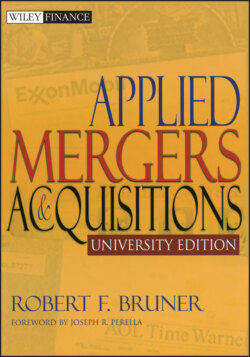Читать книгу Applied Mergers and Acquisitions - Robert F. Bruner - Страница 63
VIEWING THE WHOLE MOSAIC: SOME CONCLUSIONS
ОглавлениеWhat should a practical person conclude from this discussion? Arguably, the data support a range of views.
Does pay. This answer is certainly justified for shareholders of target firms. Also, studies of targets and buyers combined suggest these transactions create joint value. Finally, for bidders alone, two-thirds of the studies conclude that value is conserved or created.
Doesn’t pay. This is true if you focus only on bidders, and define “pay” as creating material and significant abnormal value—this line of reasoning is behind statements that 60 to 70 percent of all M&A transactions “fail.” But economics teaches that investors should be satisfied if they earn returns just equal to their cost of the lost opportunity (i.e., their required return). Therefore, the popular definition of failure is extreme. The reality is that 60 to 70 percent of all M&A transactions are associated with financial performance that at least compensates investors for their opportunity cost—against this standard it appears that buyers typically get at least what they deserve.
It depends. This is true, from the perspective of the earlier section that describes determinants of higher and lower M&A profitability. Value is created by focus, relatedness, and adherence to strategy. Diversification (especially conglomerate), size maximization, empire building, and hubris destroy value. The implication of this is that good deals are not achieved by pricing alone: Strategy and skills of postmerger integration matter immensely. Some rich insights can be derived from an examination of types of deals. The key implication of these insights is that managers can make choices that materially influence the profitability of M&A. Cleverness gets its due. So does stupidity.
We don’t know. This is true from the perspective of the earlier section that discusses how research strictly rejects null hypotheses, and never confirms alternative hypotheses. One can only test for the association of M&A with profitability, never causation. Like intellectual tic-tac-toe, you prove anything only by eliminating all the alternatives. Even after many studies, we may not have exhausted the alternative explanations. It is hard to warm up to this view. While one admires its rigor and skepticism, surely the mass of tests tells us at least something about tendencies.
All the above. This is apparently true. Each of the preceding positions has at least one leg (if not two) to stand on. While this position may be honest, this alternative gives equal weight to the various arguments, and is not very satisfying to the practical person who must decide. You must have a view.
None of the above. Perhaps the cacophony of conflicting studies leads one to pure agnosticism. Such a conclusion is harsh, and hardly the foundation for an executive who must lead an enterprise in the hurly-burly of business life.
My reading of the studies leads me to choose “Does pay, but….” I take the economists’ perspective that an investment is deemed to “pay” if it earns at least the opportunity cost of capital. Abstracting from the studies, the majority of transactions meets this test for targets, bidders, and the combined firms. But the buyer in M&A transactions must prepare to be disappointed. The distribution of announcement returns is wide and the mean is close to zero. There is no free lunch. The negative performance postmerger (see Exhibit 3.6) is troubling, but absent a rigorous strong-form test, we must await further research to see whether the poor performance is tied to the mergers or to more general phenomena in markets. In the interim, shareholders of both target and buyer firms should be cautious. The outcomes of most transactions are hardly consistent with optimistic expectations. Synergies, efficiencies, and value-creating growth seem hard to obtain. It is in this sense that deal doers’ reach exceeds their grasp.
Based on the mass of research, my advice to the business practitioner is to be coldly realistic about the benefits of acquisition. Structure your deals very carefully. Particularly avoid overpaying. Have the discipline to walk away from uneconomic deals. Work very hard to achieve the economic gains you hypothesized. Take nothing for granted. M&A is no money machine, and may well not offer the major career-building event you wanted. The only solace is that you could say the same about virtually any other form of corporate investment; on balance, your shareholders will earn a going rate of return on M&A activity. Given the uncertainties in M&A as elsewhere, one must remember the ancient advice, caveat emptor (buyer beware).
